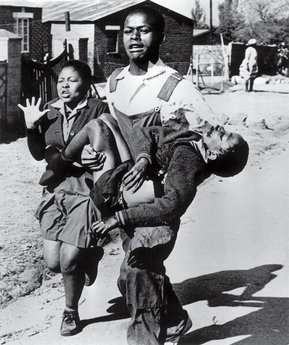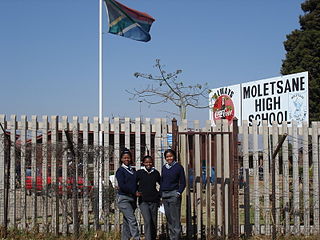
Soweto is a township of the City of Johannesburg Metropolitan Municipality in Gauteng, South Africa, bordering the city's mining belt in the south. Its name is an English syllabic abbreviation for South Western Townships. Formerly a separate municipality, it is now incorporated in the City of Johannesburg Metropolitan Municipality, and one of the suburbs of Johannesburg.
The Department of Bantu Education was an organization created by the National Party of South Africa in 1953. The Bantu Education Act, 1953 provided the legislative framework for this department.

Fatima Meer was a South African writer, academic, screenwriter, and prominent anti-apartheid activist.

Zolile Hector Pieterson was a South African schoolboy who was shot and killed at the age of 12 during the Soweto uprising, when the police opened fire on black students protesting the enforcement of teaching in Afrikaans, mostly spoken by the white and coloured population in South Africa, as the medium of instruction for all school subject whereas they wanted to learn in their native languages, Xhosa and Zulu. A news photograph by Sam Nzima of the mortally wounded Pieterson being carried by another Soweto resident while his sister ran next to them was published around the world. The anniversary of his death is designated Youth Day in South Africa.

The Hector Pieterson Museum is a museum located in Orlando West, Soweto, South Africa. Located two blocks away from where student protester Hector Pieterson was shot and killed on 16 June 1976, the museum is named in his honour and covers the events of the anti-Apartheid Soweto Uprising, where more than 170 protesting school children were killed.

Hastings Ndlovu was a schoolboy who was killed in the Soweto uprising against the apartheid system in South Africa.

The Soweto uprising was a series of demonstrations and protests led by black school children in South Africa during apartheid that began on the morning of 16 June 1976.
Popo Simon Molefe OLS is a businessman and former politician from South Africa.

Orlando Stadium is a multi-purpose stadium in Soweto, a township in Johannesburg, in Gauteng province in South Africa. It is the home venue for Orlando Pirates Football Club, a professional soccer team that plays in the Premier Soccer League and owned by the City of Johannesburg.
Zephania Lekoame Mothopeng was a South African political activist and member of the Pan-Africanist Congress (PAC).
Teboho "Tsietsi" MacDonald Mashinini in Jabavu, Soweto, South Africa, died in the summer of 1990 in Conakry, Guinea, and buried in Avalon Cemetery, was the main student leader of the Soweto Uprising that began in Soweto and spread across South Africa in June, 1976.

Internal resistance to apartheid in South Africa originated from several independent sectors of South African society and took forms ranging from social movements and passive resistance to guerrilla warfare. Mass action against the ruling National Party (NP) government, coupled with South Africa's growing international isolation and economic sanctions, were instrumental in leading to negotiations to end apartheid, which began formally in 1990 and ended with South Africa's first multiracial elections under a universal franchise in 1994.

The South African Youth Revolutionary Council (SAYRCO) was a South African political organisation. SAYRCO profiled itself as a 'third force' in the anti-Apartheid struggle. It was associated with the Black Consciousness Movement.
Meadowlands Secondary School is a government secondary school in Meadowlands a section of Soweto.

Morris Isaacson High School is a government secondary school in Soweto. Founded in 1956, the school took an important role at the start of the Soweto Uprising in 1976.

Moletsane High School is a government secondary school in Soweto, South Africa. Founded in 1972 it became a secondary school in 1976. Students from the school were involved in the Soweto Uprising in 1976. The school's public/private partnership and the school's improvements in its results were praised by the South African Minister for Education.
Samuel Sisulu was a South African anti-apartheid activist, Soweto uprising student leader and founder of South African Freedom Organisation (SAFO). He was jailed at various prisons including Robben Island in 1978, two years after the 1976 Soweto uprising. Samuel Sisulu was charged under the Terrorism Act. Reported in WIP 3. He was mentioned in the indictment of Paul Langa and found guilty of founding SAFO, attempting to cripple the economy of the country by bombing the apartheid government, inciting persons to persuade taxi drivers not to transport workers to place of work, aid strikes, unlawfully aid students in their fight against Bantu education and was also found guilty of recruiting people for military training.
Thamsanqa Kambule was a South African Mathematician and Educator. He was the first black professor at the University of the Witwatersrand, and was the first black person to be awarded honorary membership to the Actuarial Society of South Africa. He was awarded the Order of the Baobab in 2002 for his services to mathematics education.
Fezeka High School is a public high school located in Gugulethu, Western Cape, South Africa. It is one of the high schools in the City of Cape Town Metropolitan Municipality.
Bongiwe or Bongi Dhlomo-Mautloa, is a Zulu South African printmaker, arts administrator and activist.











